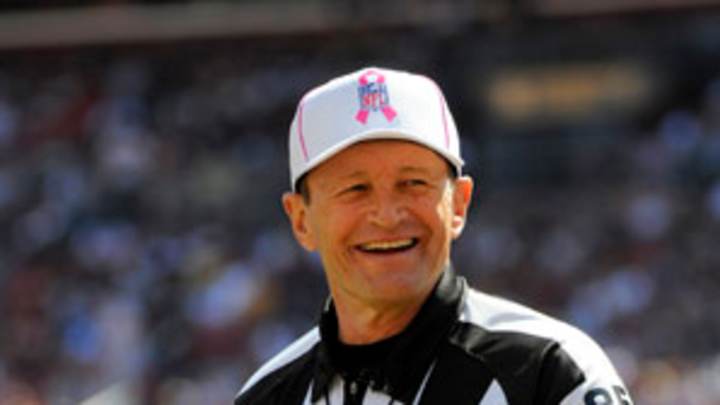Ref Ed Hochuli with an inside look at what he does on a typical play

"If it's a right-handed quarterback I'm on the right side, a left-handed quarterback I'm on the left side," Hochuli said. "My position is two or three yards wider than the offensive tackle and 13 to 14 yards behind the line of scrimmage. Then I will watch when the [offensive] team huddles to make sure there's not 12 men in the huddle. People ask me, 'Do you listen in on what the play is?' [He scoffs.] If people knew: It's like you're listening to Greek. I mean it's impossible to understand what the play is if you're listening in. So no: I don't listen in. Besides, they might audible at the line and now I'm anticipating something wrong. Anyway, I've counted the huddle, and as they break the huddle, I will recount.
I interrupt to ask Hochuli: "Why recount as the huddle breaks? Has anyone ever magically materialized in the huddle while you weren't looking?"
"Nooo," Hochuli says slowly, with the patience of a man accustomed to head coaches and other hecklers. "It's in case you counted wrong in the huddle. We are paranoid about counting. I am anal about counting. We all signal each other. Three guys are counting the defense and four guys are counting the offense and we give signals to confirm with each other that the numbers are right. So as they approach the line I recount and as I'm doing that, now I've also seen the formation, and the formation is going to affect who is covering who. It makes a difference, for example, if there is a trip to this side versus a trip to that side. So anyway, I signal to my counterparts that I've got 11 [men on offense]. Then as I get set and the quarterback gets under center or sets the shotgun, that's when I will say to myself -- out loud -- 'Left hash, lock and load.'"
"Lock and load" is a mantra Hochuli repeats, out loud, every single time the quarterback goes under center. He is a movie and baseball buff, and he recalls the film For Love of the Game, in which Kevin Costner played an aging Detroit Tigers pitcher who blocks out hostile crowd noise with an audible mantra of his own: "Clear the mechanism." Hochuli's mantra then, before every snap, is: "Lock and load."
"Educators will tell you that by saying it out loud you remember it better than if you just say it to yourself," he continued. "I need to remember that that ball was snapped from the left hash mark because that's gonna tell me where the pocket is, tackle to tackle. And once the play develops, I still have to have in mind, 'Where is that pocket?' It matters for a lot of reasons. So I've locked that into my mind where the ball was snapped. I'm watching the center and the quarterback primarily to see that the ball is snapped and there's no false start, but out of the corner of my eye I've got both of the backs in vision, too, because if they false start that's also my responsibility. So I've got to see if there's any sudden movement by them.
"Once the ball is snapped we go into what our different responsibilities are depending on where the play goes [and whether that play is a run, pass, play-action, etc.]. At the end of the play, more often than not, I'm the one that spots the ball, so I also have to know which hash mark it was. If it was an incomplete pass I need to know which hash mark we're going back to."
Fortunately," left hash, lock and load" is still ringing in his ears in that instant. All of this transpires, remember, in a few scant seconds, and may be made infinitely more complicated by a penalty or turnover or other anomaly, after which it's time to lock and load again -- and again and again -- 150 to 160 times a game.
